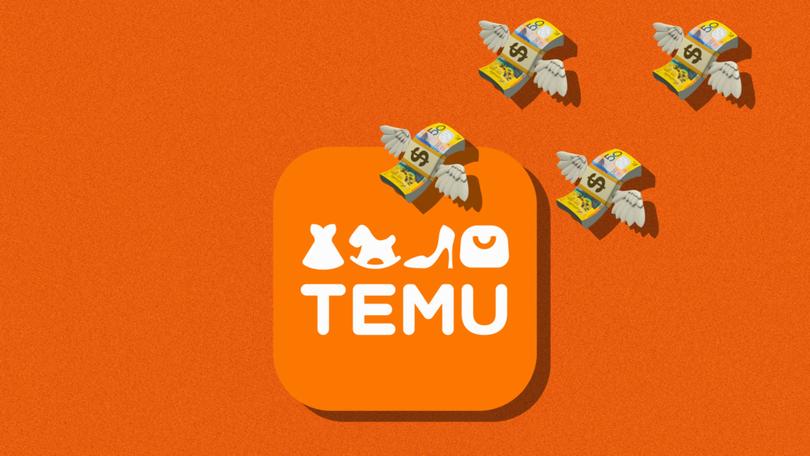Temu: You might get a discount but you’re also being played by the multi-billion dollar gamification industry

You’re scrolling through your socials and an app for an online shopping site appears. You click the link but, before you can see any merchandise, a spinning wheel flashes up and invites you to press the button to spin. You do and you win 50 per cent off any purchase. How good is that?
This is gamification and the spinning wheel example is used by Temu, the multi-billion online marketplace operating out of China from which you can purchase almost anything.
Gamification — the use of game elements in non-game contexts to increase participation — is on the rise.
Sign up to The Nightly's newsletters.
Get the first look at the digital newspaper, curated daily stories and breaking headlines delivered to your inbox.
By continuing you agree to our Terms and Privacy Policy.Businesses use it to attract customers, boost sales and motivate employees to complete activities to drive profits.
The global gamification market is expected to increase in value from $23.6 billion in 2024 to $74.8 billion by 2029. This is the total revenue generated from products and services related to gamification, including software, platforms and applications.
The use of goals, points, badges, opportunities to level up and leader boards is now common in many industries ranging from education to health and wellbeing.
For example, Fitbit, the fitness tracker company, monitors users’ physical activities and gamifies the experience by rewarding badges for achieving milestones and allowing users to compete in challenges with friends.
Does gamification work?
There’s a good reason why gamifying in business is growing — it works.
It works so well some engagement platform providers advertise gamifying a platform will increase website traffic by 50 per cent and double social engagement.
Academic research is mounting to support the claim gamification increases customer engagement, which in turn increases positive word-of-mouth and boosts brand loyalty.
A good example is the annual McDonald’s Monopoly promotional marketing game. Based on the classic Monopoly board game, customers receive game pieces with their purchase of certain menu items.
By collecting these pieces, they can win prizes, either instantly or by completing sets. Of course, some pieces are rarer than others, encouraging customers to keep spending until they get a full set.
According to one analysis, the chance of winning a major prize is well over one in a million.
In 2020, McDonald’s Australia customers scanned 42 million Monopoly prize tickets and downloaded 2.5 million extra apps. Despite giving away $50 million worth of prizes, the campaign achieved a return on investment of $2.33 for every dollar spent.
Companies are learning that if they understand customers’ motivations when engaging with gamified systems, they can create more personalised and effective gamification.
A research-based framework is used to identify six types of gamification users. They are socialisers, free spirits, achievers, philanthropists, players and disruptors.
For example, achievers want to learn new things and improve themselves and so are more engaged with challenges whereas philanthropists are motivated by purpose and meaning.
Why does gamification work?
Gamification is effective because it draws on the psychology of both extrinsic and intrinsic motivation.
Extrinsic motivation causes you to act because of external forces. This is driven by the desire to get a reward or avoid punishment. For example, you might take a job to earn money. In the context of a loyalty program, you might make repeated purchases from Starbucks to earn a free coffee.
Rewards can be structured in ways that take advantage of our psychology. For example, the goal gradient effect describes a tendency for motivation to increase the closer you are to achieving a goal.
This tendency can be taken advantage of by enrolling you in a reward program of, say, “Buy ten, get one free” and giving you the first two stamps for free.
Intrinsic motivation causes you to act because of internal forces. This type of motivation is driven by what you consider inherently interesting, enjoyable, or satisfying.
For example, you might go hiking on weekends to enjoy the natural wonders. In the context of a loyalty program, you might go for a surf while earning points in your Rip Curl Club account.
According to self-determination theory, there are three principles that can be leveraged to engage people’s intrinsic motivation.
The first is autonomy, which reflects people want to be in control. Gamification can offer choices and personalisation such as choosing different types of challenges or rewards or customising avatars.
The second is competence, which reflects that people want to achieve. Gamification can offer challenges of varying levels of difficulty that allow users to develop skills and feel a sense of pride as they accumulate points and badges and move up a leaderboard.
The third is relatedness, which reflects that people want to be connected with others. Gamification can offer social features like team challenges or community leaderboards that enable social interaction and recognition.
The problems with gamification
Despite the many success stories, gamification is not always a good thing.
For example, one study of supermarket shoppers found no effect on their behaviour when promotions were picked up by their location-sensitive phones while they were in the store.
Another study found customers who lost a contest became less engaged
… win/lose decisions weaken the benefits of gamification and, in the case of losing a competition, have negative impacts on customer experience and engagement.
Another analysis found gamification may result in customers being manipulated, exploited and psychologically distressed.
These issues can arise because customers, among other things, are more likely to disclose personal information on gamified platforms. Customers become more confident and willing to provide their details when they can measure their performance against others.
Gamification can also cause consumers to over consume and overspend.
For example, in some markets the Starbucks’ reward app offers time-sensitive Star Dashes and Bonus Star Challenges, which are redeemable for free or discounted items.
Some customers report buying coffee they do not want simply to bank stars.
It’s worse for some airline customers who board flights to destinations they are not interested in visiting merely to collect frequent flyer points in a so-called “mileage run”.
But it is possible for gamification to be a win-win for companies and customers. To get there, marketers need to ethically employ gamification mechanics. This involves collaboration with gamification designers and transparency with customers.
Adrian R. Camilleri, Associate Professor of Marketing, University of Technology Sydney
This article is republished from The Conversation under a Creative Commons license. Read the original article.
